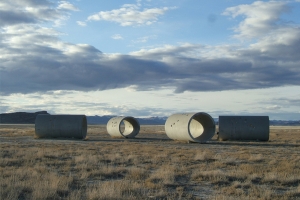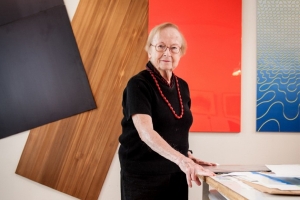Displaying items by tag: Woman
Women in Art: Nancy Holt
Nancy Holt’s photography of her seminal land work Sun Tunnels (1973-6) is part of the UMFA’s permanent collection. In anticipation for the all-female exhibition in the UMFA’s Contemporary and Modern gallery when it reopens on August 26, 2017, The Finer Points will be highlighting female artists from the UMFA’s collection, the state of Utah, and the University of Utah.
Writen by guest writer and MFA Student Allison Pinegar.
Best known for her work Sun Tunnels in the Great Basin region, Nancy Holt is one of the few women to break through the male-dominated land art movement in the 1960s and ‘70s. Growing up in Massachusetts, Holt attended Tufts University and studied biology. Afterwards, she made her way to New York where she began collaborating and working with other young artists like Carl Andre, Eva Hesse, Michael Heizer and Robert Smithson, her future husband. Before her interest in land art, Holt experimented with photography and video. She continued to work with these mediums to document her large sculptures throughout her career.
Cylinders, concrete, minimalist forms, light and shadow, and cyclical time are all common elements incorporated in Holt’s works. Unlike some of her contemporaries, Holt was not concerned with creating the largest land monuments, but rather focused on bringing the expansive desert landscape down to human scale. Sun Tunnels in western Utah is made of four large, concrete pipes arranged in a loose X-form. The tunnels are aligned with the sunset and sunrise of summer and winter solstice. Small holes drilled in the top of each tunnel correspond with specific constellations (Draco, Perseus, Columba and Capricorn). These small holes and the tunnels in general, act as a kind of camera or as view-finders that help visitors manage the extreme vastness of the desert landscape, by allowing the viewer to focus in on single elements. The holes also project the sky onto the ground, inverting the earth-sky relationship. Holt provides new aesthetic perspectives that encourage viewers to engage with their surroundings.
Holt was one of the first in the land-art movement to connect her work with eco-activism. She used her works as a platform to discuss conservation, environmental protection and stewardship. Holt’s work never competes with the landscape, but tries to start a dialogue between the viewer and the environment. Holt’s lack of interest in creating monumental land art pieces initially made it difficult for her to gain prominence in the art world, especially when competing with artists like Smithson and Richard Serra. At a public lecture in 2010 Holt stated, “I was just being. I was emphasizing being over becoming. And in the art world it’s a hard stance.”
For more information about Nancy Holt and visiting Sun Tunnels visit here.
Artist Highlight: Anna Campbell Bliss
By Guest Writer and MFA Student, Allison Pinegar
Anna Campbell Bliss is just one of the artists who will be featured in the all-female exhibition in the UMFA’s Contemporary and Modern gallery when it reopens on August 26, 2017. In preparation for the all-female show, The Finer Points will be highlighting female artists from the UMFA’s collection, the state of Utah, and the University of Utah.
The work of Anna Campbell Bliss is organized and structural, yet organic and experimental. The first thing that typically hits the viewer when confronted with Bliss’ work is the extraordinary use of color. A student of the Bauhaus greats like Walter Gropius of Harvard and Josef Albers of Black Mountain College, Bliss developed a unique way of integrating color theory with architecture and technology. While her style is difficult to define, one common theme throughout her career is intersectionality. Bliss’ works combine form, pattern, structure, color, texture, science, mathematics, nature, dance, and poetry.
Bliss moved to Salt Lake City with her husband Robert when he accepted a teaching position in the School of Architecture at the University of Utah. Moving from Minneapolis, the Blisses left behind their active architecture firm, Bliss & Campbell Architects, and a vibrant arts community where they were highly involved with the Walker Art Center. When Bliss arrived in Utah in 1963, she felt as though she had been exiled to a “cultural desert.” The lack of art funding and activity in Salt Lake pushed Bliss to establish the Contemporary Arts Group, a group of artists, engineers, dancers, poets, and architects working together to build up support for the arts in Utah.
A true descendent of the Bauhaus, Bliss looked to Utah’s burgeoning technology industry for additional creative inspiration. Much of Bliss’ later work uses computer algorithms and draws from scientific experimentation. Bliss’ was never fully dependent on computers or technology in her process – she firmly believed in the significance of the artist’s hand. That unique touch is what allows these various disciplines to work together cohesively.
Bliss’ ties to the University of Utah through her husband allowed the UMFA and the University to collect a considerable amount of Bliss’ work. Extended Vision, a large mural commissioned for the Cowles Mathematics Building in 2001 is a significant addition to the sixteen pieces in the UMFA’s permanent collection. Bliss worked well through retirement age before her career garnered serious attention and was still actively working when she passed away in 2015 at the age of 90. Some of her works have been collected by large institutions, but she did not receive her first commission until 1989 at the age of 64 when she installed Windows at the Salt Lake Airport.
Anna Campbell Bliss ushered modernism into Utah’s art world and stimulated the Salt Lake art community into much of what it is today. Be sure to look for Bliss’ Celebration in the UMFA’s contemporary gallery when it re-opens in August 2017.



